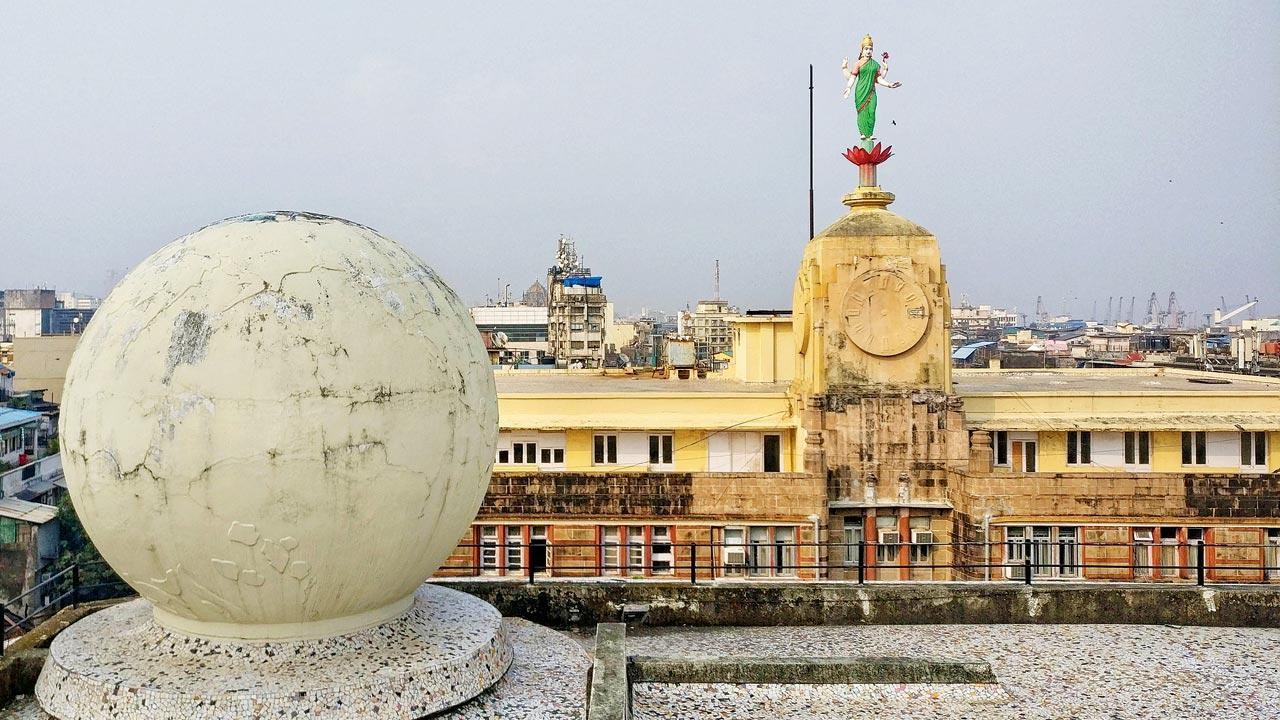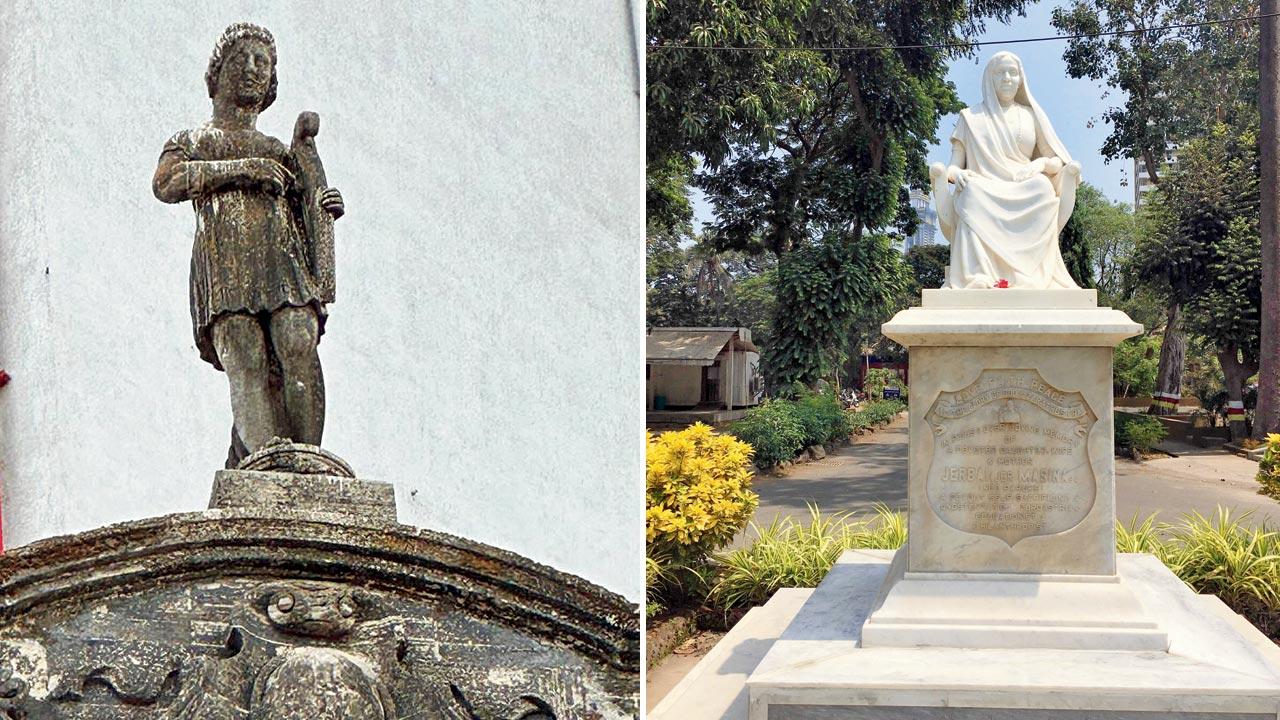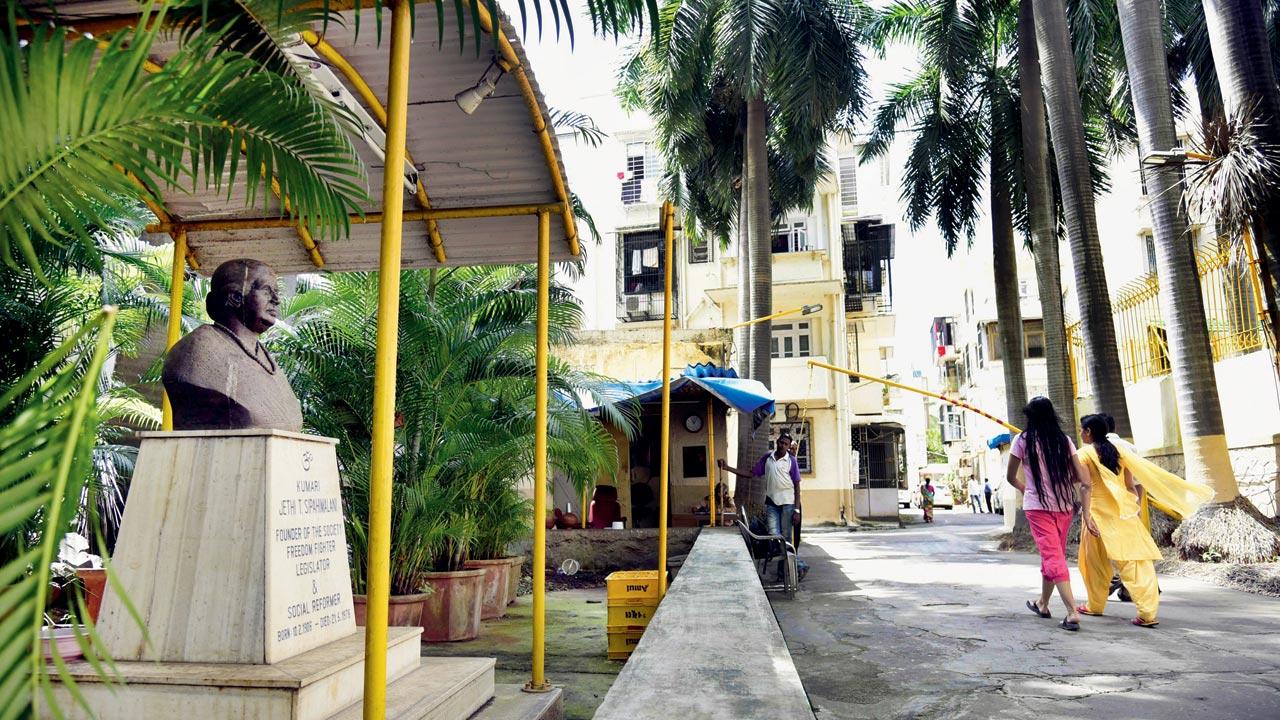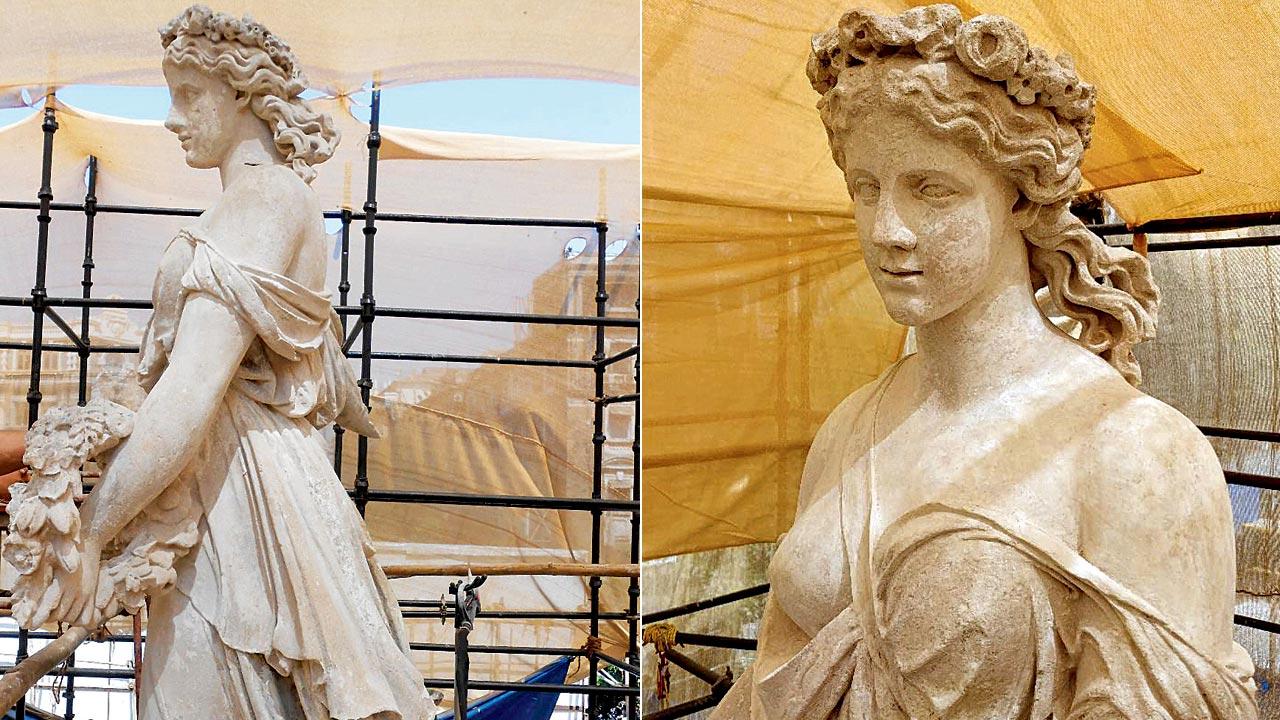Commemorative and ornamental, sculptures of women of substance light up roofs, paths and gardens across Bombay

Lakshmi Insurance Building on PM Road, Fort. Pic/Chirodeep Chaudhuri, Seeing Time: Public Clocks of Bombay
 They grace many a dome and driveway. Some obvious, some hidden. Clad in marble, metal or stone, each paying tribute to women who have proved pioneering and inspiring, brilliant and brave, these busts and statues honour Bombay’s best and brightest.
They grace many a dome and driveway. Some obvious, some hidden. Clad in marble, metal or stone, each paying tribute to women who have proved pioneering and inspiring, brilliant and brave, these busts and statues honour Bombay’s best and brightest.
ADVERTISEMENT
From lofty goddesses to ordinary citizens achieving extraordinary victories for the larger good, here are a few of our favourite ladies frozen in stone for posterity.
Starting on an auspicious note with the 18-feet-high bronze Lakshmi my gaze has eagerly lit on since the days of patronising Strand Book Stall next door. She benignly blesses the world beneath her feet from a three-sided tower with a (once) chiming clock on Lakshmi Insurance Building at PM Road in Fort. Aptly presiding over the mercantile precinct, the goddess of wealth has her trusted vahana vehicle, the elephant, sculpted as a leitmotif by RP Kamat in facade reliefs.
The Lakshmi Insurance Company of Lahore was established in India in January 1936, by founders as distinguished as Lala Lajpat Rai and Motilal Nehru. Two years later, Subhash Chandra Bose inaugurated the Art Deco Lakshmi Insurance Building designed by Master, Sathe & Bhuta.
 Statue of a young girl holding a harp atop Gulab Mahal, Tardeo. Pic/Shormistha Mukherjee; (right) Jerbai Masina on the Masina Hospital lawn, Byculla. File pic
Statue of a young girl holding a harp atop Gulab Mahal, Tardeo. Pic/Shormistha Mukherjee; (right) Jerbai Masina on the Masina Hospital lawn, Byculla. File pic
The Lahore link is interesting. Two buildings acknowledging the same goddess rose in quick succession in Pakistan. One on MA Jinnah Road in Karachi (previously Bandar Road because it connected to the port) had red bricks imported from Jaipur. The other came up near Mall Road in Lahore.
Lahore’s Lakshmi Building was the mansion of Sir Shadi Lal. The first Indian to become Chief Justice of a High Court, he served between 1920 and 1934 as Chief Justice of Lahore High Court. It passed on in 1930 to Lakshmi Insurance Company. Partition saw the building house the Muslim League offices before it became the address of personalities including Urdu literato Saadat Hassan Manto and former caretaker Prime Minister of Pakistan, Malik Meraj Khalid.
About the other Lakshmi Building, with its own clock tower and iron elevator, Usman Damohi notes in his book, Karachi in the Mirror of History: “Before Partition, Lakshmi Building was tallest in Karachi, in the centre of the commercial area on Bandar Road. It was inaugurated by the famous Indian political figure, Sarojini Naidu, on December 24, 1938. Back then, a sculpture of the deity Lakshmi could be seen atop the structure.”
 Jethi Sipahimalani memorial at the Navjivan Society entrance, Mahim. File pic
Jethi Sipahimalani memorial at the Navjivan Society entrance, Mahim. File pic
Not far from Fort, also in the business district heart, the goddess Flora graces the exquisite, eponymous fountain at Hutatma Chowk, the circle hailed as Bombay’s Piccadilly Circus. The choice of Flora, the Roman goddess of flowers—suggesting spring, fertility and plenty—owed to a commission for the Agro Horticultural Society of Western India. Initially meant to be situated in Byculla’s botanical gardens within a central roundabout, its placement changed to the present spot to highlight restructuring attempts of the city wherein new public architecture replaced the Bombay Fort walls.
“The statuary of Flora Fountain is par excellence, among the city’s finest Victorian examples. It consists of Flora at the peak and four allegorical images in niches on the lower level: symbolising industrial, cereal, plant and fruit products of India,” says Vikas Dilawari who restored the monument, which won the UNESCO Heritage Award. “Because of the scaffolding erected, I fortunately saw Flora’s elaborate ornamentation at eye level. Most gracefully sculpted, she is to be appreciated for details of the hair, face and hands, and the drape of fabric on her. The fountain was painted over for decades, accumulating the dust and grime of pollution. Perhaps even Flora, witnessing the city for close to 160 years, would have felt sad. But restoration and upkeep have brought back her former glory. This is extremely satisfying and gives hope to conservation.”
The collaboration between the architect Richard Norman Shaw and sculptor James Forsythe, rendering the fount in imported Portland stone, is exceptional. Especially when you consider that never having visited India, Shaw and Forsythe brought in elements like seashells, dolphins and beasts to capture local flavour in a European creation.
 Close view of Flora of Flora Fountain at the time of restoration in 2018. Pics/Vikas Dilawari
Close view of Flora of Flora Fountain at the time of restoration in 2018. Pics/Vikas Dilawari
Though colonial embellishments on domes, parapets and pediments mark several structures, they assume greater significance on a vital railway hub. Not far from Flora’s abundant femininity, the Lady of Progress crowning the dome of Victoria Terminus is a fine display of sheer strategy. Overlooking the eastern shoreline, close to warehouses storing imported and exported goods, the very visible, optimistic sign of progress is spotted easily across the harbour.
Modelled on the lines of St Pancras in London, Victoria Terminus commemorated 50 years of Queen Victoria’s reign when it was unveiled in 1887. This statue, 16 feet in height and executed in marble by Thomas Earp, completes FW Stevens’ masterpiece. Sporting flowing robes and a star above her forehead, Progress bears a winged wheel by her side, suggestive of onward movement, speed and transport. Her demeanour benign, she holds up a flaming copper-gilt torch, as if to illuminate and lead the advance towards a glowing future.
A major impediment to a flourishing city is the danger it must repel from external invasion. Could Athena, the Greek goddess of war, soaring 11 feet high from the roof of the BJPC (Byramjee Jeejeebhoy Parsee Charitable) Institution have been placed to invoke protection? Lost for some years, the west-facing figure wielding an assertively long spear and shield was replaced by a hoarding advertising the 501 Soap bar. Invited to restore the originally limestone Athena to her empowered status in 2008, structural engineer Kiran Bhavsar used fibre reinforced plastic as the material. The helmeted statue is clearly on view for train commuters from Charni Road Station and the overbridge.
“Athena seems ready to take on the world, yet strikes a pose of gentle power, an ideal combination of qualities,” says Bhavsar. He is reminded of Michelangelo’s David—exemplifying humanism with independence and strength, assuming the stance of calm readiness till called to defensive battle.
From myth to reality. Stroll around Masina Hospital in Byculla to be suffused with a serene thought from HW Longfellow’s poetry. These soothing words beneath Jerbai Masina’s statue on the front lawn lift the frailest mood: “There is no death, what seems so is transition, from breath to life Elysian.”
Masina is regarded as Bombay’s first private hospital in 1902, followed by Parsi General Hospital in 1908 and Harkisondas Hospital in 1925. Credited with the
city’s inaugural neonatal care unit, it has dealt with pandemics from the 1918 Spanish flu to the Coronavirus. My aunt, Dr Maharukh Joshi, headed the paediatric department there. Waiting on occasion with the family to take her home, I had time enough to explore the carved surfaces around Jerbai’s statue. The hospital was Sans Souci, the palatial 19th-century residence of the eminent Baghdadi Jew trader and philanthropist, David Sassoon.
The Sassoons bequeathed the property to Dr Hormasji Manekji Masina who treated David Sassoon for an acute hernia attack. The third Indian to be granted the Fellowship of the Royal College of Surgeons, Dr Masina raised charity funds for the hospital of his dreams with his devoted wife Jerbai. It was she who established the Postgraduate Medical College and Lady Broacha College of Nursing in 1923.
Taking care of yet another vulnerable section of society, Jethi Sipahimalani, Deputy Chairman of the former Sind Legislative Assembly and Member of the Maharashtra Legislative Council, has a bust dedicated to her at the gate of Navjivan Society on Mori Road in Mahim. The enclave is synonymous with affordable accommodation for at least 1,600 homeless migrant families, slowly rehabilitating after Partition through such schemes at Mahim, Matunga, Chembur and Lamington Road. Desperate Sindhi and Sardar refugees starting from scratch in camps and colonies, have woven the bravest struggle-to-success narratives from these shelters.
Another moving memorial to compassion—this one for all creatures furry and feathered—is Lady Sakarbai Petit’s, on the grounds of the Bai Sakarbai Dinshaw Petit Hospital for Animals. Referred to as Bail Ghoda Hospital in common parlance, entry to the premises is under an arch adorned with charming dog, cat and bullock sculptures. It is named after the animal lover wife of Sir Dinshaw Manockjee Petit who gifted the Parel estate to the Bombay Society for the Prevention of Cruelty to Animals. Lord Dufferin, the Viceroy of India, opened the facility to the public in 1885.
To end with a hint of mystery. Not much is revealed about an intriguing young girl in Porbunder stone: holding a harp atop Gulab Mahal, from where she has surveyed the chaos of Tardeo’s crowded Sane Guruji Marg since 1924. Her right hand is shown plucking the small lyre-like string instrument clutched in the left. Pacing the compound, Shormistha Mukherjee—who discovered this terrace statue on one of her slow bicycle-through-Bombay trips during lockdown—and I learn little beyond the idea that the diamond jeweller Hirachand Mangalbhai Jhaveri likely had the building constructed and named for his son Gulabchand.
Why was this classic young lady with a lyre conceived a hundred years ago to make sweet music on a road its oldest residents dubbed Kacharpati Gully? We wait to hear what more you may know, dear reader.
Author-publisher Meher Marfatia writes fortnightly on everything that makes her love Mumbai and adore Bombay. You can reach her at meher.marfatia@mid-day.com/www.meher marfatia.com
 Subscribe today by clicking the link and stay updated with the latest news!" Click here!
Subscribe today by clicking the link and stay updated with the latest news!" Click here!







